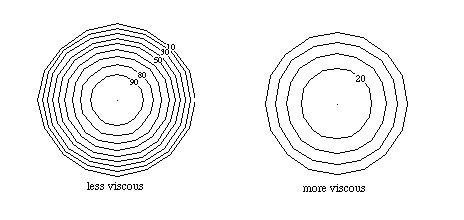where DP is the pressure difference between the "head" (upstream) and "tail" (downstream) ends of the pipe, a is the radius of the pipe, r is the position along the diameter from the center, l is the length of the pipe and h is the viscosity of the fluid. For a cross section of the pipe, the velocity gradient has circular symmetry:

The fact that the velocity is constant on each circle leads us to think of the fluid as flowing in concentric "sheets", but in fact the velocity is a smooth function of distance from the center. For higher viscosity, the velocity gradient is shallower. Essentially, viscosity opposes the existence of steep velocity gradients. The larger the viscosity, the "gentler" is the shape of the parabolic velocity gradient, and the velocity is more nearly constant across the section.